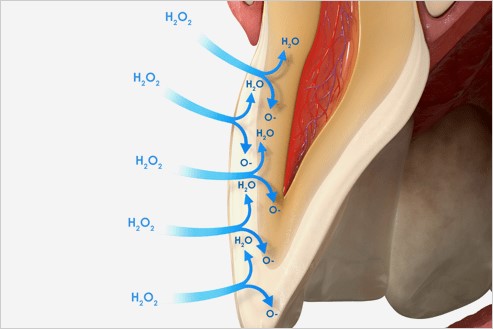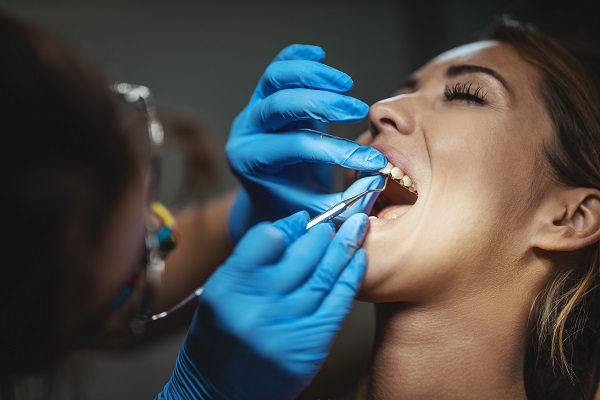Teeth Whitening You Can Trust
The Beginning of Brighter Smiles
Jaleena was persistent, “Dad, I need my teeth whiter. Dad, I need my teeth whiter.” She would even cut out teeth whitening advertisements from dental journals and leave handwritten reminders on her dad’s nightstand. As Dr. Fischer’s teenage daughter, Jaleena was determined to keep her dad’s attention focused on developing what would become Opalescence Teeth Whitening. One night, over 30 years ago, when Dr. Fischer was finally satisfied with the whitening gel he and his team had developed, he took it home to Jaleena. He had her load the new whitening gel into the tray before bed and asked her to wear it throughout the night. “When you wake up in the morning don’t take the tray out,” he said. “Come find me, and we’ll take it out together.” The next morning, they took the tray out and discovered that—after just one night—the teeth that had been treated with Opalescence whitener were two shades whiter!How Opalescence Teeth Whitening Works
The secret was the viscosity of the Opalescence whitening gel. Dr. Fischer knew it needed to have a sticky, viscous composition for the gel to stay in place and provide sustained peroxide release for superior whitening results. Opalescence whitening gel’s distinctive viscosity keeps the gel in place, allowing the peroxide to enter your enamel and do its job. Whitening occurs as oxygen molecules from the whitening agent spread throughout the tooth and react with the discolored molecules in your teeth. This means that the entire tooth is whitened, even if the whitening gel isn’t in contact with every part of the enamel. This safe, non-invasive, and effective whitening method is what has made Opalescence whitening the global leader in teeth whitening and trusted by dentists and patients alike.
It’s been thirty years since that eventful morning for Jaleena and her dad. In that time, Opalescence whitening has helped millions of people brighten their smiles, giving them more confidence and improving their quality of life. It can do the same for you! Explore your whitening possibilities and talk to your dentist today about which Opalescence whitening product is right for you.
Whitening occurs as oxygen molecules from the whitening agent spread throughout the tooth and react with the discolored molecules in your teeth. This means that the entire tooth is whitened, even if the whitening gel isn’t in contact with every part of the enamel. This safe, non-invasive, and effective whitening method is what has made Opalescence whitening the global leader in teeth whitening and trusted by dentists and patients alike.
It’s been thirty years since that eventful morning for Jaleena and her dad. In that time, Opalescence whitening has helped millions of people brighten their smiles, giving them more confidence and improving their quality of life. It can do the same for you! Explore your whitening possibilities and talk to your dentist today about which Opalescence whitening product is right for you.
FAQ’s of Opalescence Teeth Whitening
Q. How does Opalescence teeth whitening work?
A. Opalescence teeth whitening involves the removal of stains and discolorations from the enamel and dentin. The outer layer of the tooth is enamel, and beneath the enamel is dentin. Enamel is thin and typically much lighter in color, while dentin is darker in color and makes up the bulk of the tooth. Enamel can be discolored over time simply from age, but also from outside sources like coffee, tea, tobacco, and other foods and beverages. Also, as we age, our enamel thins, causing more dentin to show through, making the overall appearance of the tooth look darker.
Whitening your teeth removes these stains and discolorations, giving you a whiter, brighter smile. The active ingredients in Opalescence whitening gels pass into your teeth to oxidize the discolored molecules deep down in your teeth, removing stains and whitening your smile. Our original, patented formula contains PF (potassium nitrate and fluoride) and is sticky and viscous, so it stays where it’s placed. This unique feature prevents the gel from seeping out during treatment, ensuring both the gel and tray stay in place and work effectively for the duration of your treatment.Q. Why should I whiten my teeth?
A. People whiten their teeth for many reasons. You can bring back some of that youthful appearance with a whiter, brighter smile. Do you have a wedding or important day coming up? A whiter smile can help brighten up special occasions. Some people whiten their teeth before a job interview to get that extra boost of confidence that comes with making a great first impression.
According to a recent survey by the American Academy of Cosmetic Dentistry, “close to one in two (48%) people believe that a smile is the most memorable feature after first meeting someone—more so than the first thing a person says (25%).” That same survey also found that “more than a third of respondents view people with a flawed smile to be less attractive (37%) and less confident (25%) than those with perfect teeth.”6 Smiles make a lasting impression and a bright, white, beautiful smile won’t be forgotten. People seem to agree—nothing beats a beautiful smile!Q. Is Opalescence teeth whitening for everyone?
A. Opalescence teeth whitening is a safe, comfortable way to get a bright, white smile. Results and treatment time may vary depending on the level of staining and whiteness desired. Crowns, bridges, fillings, and veneers will not whiten. Pregnant women, breastfeeding women, those with gum disease, worn enamel, cavities, and exposed roots may not be good candidates for whitening their teeth. We recommend visiting your dentist for a pre-whitening consultation so that they can help you choose the professional option that best fits your needs.
Q. What options are available to whiten my teeth?
A. Opalescence whitening has been specially formulated and is available in many different concentrations, delivery options, and flavors. This means that you can whiten in a way that best fits your lifestyle. Whether you want to whiten your teeth with a custom tray, prefilled tray, or with an in-office-whitening treatment, Opalescence has a professional whitening option for you.
Q. Will teeth whitening cause tooth sensitivity?
A. Tooth sensitivity is a relatively common side effect of teeth whitening. No harm is caused to your tooth as a result of a whitening treatment, and this discomfort is not an indication of damage to your tooth. If sensitivity occurs, it is most often temporary and will go away when you've completed the whitening process. If you do experience tooth sensitivity, there are ways to treat it using desensitizing toothpastes and gels such as Opalescence Whitening Toothpaste Sensitivity Relief or UltraEZ desensitizing gel. Consult with your dentist to determine the best treatment for your needs.
Q. Why doesn’t Opalescence whitening require a teeth whitening light?
A. Lots of other in-office whitening treatments use a light or a laser during the whitening process. You've probably seen commercials for these kinds of teeth whiteners. Or maybe you've even seen kiosks in the mall where they use a light to whiten your teeth. Are these lights and lasers really effective, though?
The answer is no. Current research shows that only hydrogen peroxide (the whitening agent used in Opalescence Boost in-office whitening and Opalescence Go tray whitening) or carbamide peroxide (the whitening agent used in Opalescence PF custom-tray whitening) are effective in whitening teeth. Light activation adds no additional benefit.7 In fact, some research shows that using a light for whitening can be harmful to lips and gums.Q. Can I whiten a crown or a filling?
A. No, only natural tooth structure can be whitened, any crowns or fillings that you have will not react to whitening products. If you have a crown or a filling that is easily visible, you may want to talk to your dentist about different options for improving your smile.
Q. How fast can I whiten my teeth?
A. Everyone responds differently to whitening treatments and everyone will whiten at different rates. Some stains are easier to treat than others. Teeth that are yellow or brown are easier to whiten than teeth that are gray-ish. Younger patients typically whiten more quickly than older patients, but every patient is different.
When whitening, keep in mind that your smile looks most natural when the color of your teeth matches the whites of your eyes. Some people want a Hollywood white smile, but that is not a natural color for teeth and few people can actually reach that color of white. Compare strengths and wear times for our various Opalescence whitening products and consult with your dentist to help determine the right option for you.Q. How long do Opalescence teeth whitening results last?
A. Opalescence teeth whitening results are very stable, leaving you with a stunning smile long after treatment is over. However, there are a few factors that can make teeth lose their luster. Things like genetics, diet, age, some medications (like tetracycline), and certain habits (like smoking) may affect the length of your whitening results. Fortunately, touch-up treatments are quick and easy, helping you get that bright, white smile back.
Q. How do I get Opalescence teeth whitening?
A. Opalescence teeth whitening is only available from dental professionals. This ensures that you receive safe, untampered, and real Opalescence whitening. After a routine exam to ensure you are a good candidate for teeth whitening, your dentist will provide you with the right Opalescence whitening product for your needs.
Definition of Cosmetic Dentistry Terminology
- Bleachorexia
- Bleachorexia is when people continue to abuse teeth whitening solutions without consulting professionals, causing significant damage to their enamel and gums in the process.
- Carbamide Peroxide
- Carbamide peroxide is a solution that contains hydrogen peroxide and can help to whiten teeth.
- Cosmetic Dentistry
- Cosmetic dentistry is generally used to refer to any dental work that improves the appearance (though not necessarily the function) of a person’s teeth, gums and/or bite.
- Deeper Teeth Stains
- Deeper teeth stains are stains that require professional oral health services and can result from certain foods, beverages or improper oral hygiene.
- Dentin Hypersensitivity
- Dentin hypersensitivity is when the enamel wears down on the tooth enough that the dentin faces exposure and will cause great levels of pain when a person applies pressure to the tooth or drinks hot/cold beverages.
- Dentist
- A dentist, also known as a dental surgeon, is a doctor who specializes in the diagnosis, prevention, and treatment of diseases and conditions of the oral cavity.
- Hydrogen Peroxide
- Hydrogen peroxide is a chemical compound in teeth whitening solutions that patients use to whiten the shade of their teeth.
- Relief ACP
- Relief ACP stands for amorphous calcium phosphate, which helps to relieve the pain in sensitive teeth in a gel form.
- Stained Dentin
- Stained dentin can result from certain foods and beverages with a lack of proper brushing. Dental professionals can provide whitening treatments to brighten the teeth.
- Surface Enamel
- The surface enamel is the hard outer shell that protects the dentin and pulp of the teeth. The enamel is the surface that people see when one smiles.
- Surface Teeth Stains
- While surface teeth stains can be inevitable with age, certain foods and beverages will only promote discoloration and faded teeth.
- Teeth Whitening Concentrate
- Teeth whitening concentrate is the bleaching agent that whitens the shade of teeth, which is more effective from a professional and not a general store product.

![A Kid Friendly Dentist In Wilmington Explains How Sugar Can Affect A Child&# ;s Oral Health [Quick Guide]](/wp-content/uploads/kid-friendly-dentist-2203.jpg)


